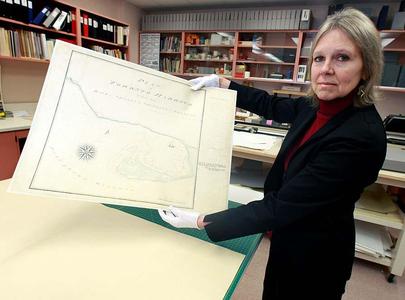Karen Teeple lays on a table the oldest object in the Toronto Archives.
It is dated Nov. 15, 1792, and it is a chart of Toronto Harbour signed by Joseph Bouchette.
It is one of her treasures.
It is also one of your treasures: a gift to Toronto and its residents made 75 years ago by a descendant of John Graves Simcoe.
Teeple, as the city archivist, is anxious to share the wealth of writings, maps, photographs and records of all kinds that cram the archives, on Spadina Rd. near Dupont St., just down the hill from Casa Loma.
Her mission, in her own words:
“Toronto is a major city that’s got a very illustrious past. I think we are responsible to ensure that Toronto’s history is preserved and made accessible to its citizens.”
The archives shelter millions of documents, in 123,000 boxes. Some have obvious significance: The city’s original incorporation document from 1834 lies here. So does the official version of the City of Toronto Act, deposited by Mayor David Miller and municipal affairs minister Brad Duguid on New Year’s Day, 2007.
Some are merely wordy, such as the official minutes of all Toronto council meetings, including the minutes of the city, borough, village and Metro municipal governments that preceded them.
But the archives also house myriad images: a million photographs; thousands of maps; a collection of antique glass projector slides.
“My favourite has to be the earliest known views of Toronto,” says Teeple, from a series of photos taken from the roof of the Rossin House Hotel in 1856-57. Standing five storeys high at the southeast corner of King and York Sts., it was then Toronto’s tallest building. The photos make up an almost complete panorama of the city.
The photos are not locked away: They hang in the lobby of the archives. They are also featured in the book of official photographs that Teeple and fellow archivists Steve MacKinnon and Michele Dale produced earlier this year. The book – Toronto’s Visual Legacy – is almost sold out. It’s available at Indigo.
“The success of the book speaks to the passions and interest that Torontonians have about their past,” says Teeple, who was drawn to archival work in the 1970s as a graduate student in Canadian studies. “There are other archival institutions in the city – bank archives, religious archives – but when it comes to ensuring that Toronto’s history is preserved, we are pretty much one of the only institutions around.”
The images in photos, maps and glass slides – meticulously catalogued and preserved by the archives staff – are the most instantly compelling items in the archives.
Bouchette’s chart, for example, shows what was important to him. While it meticulously describes the harbour bottom, he notes only four features on land: Two houses, “Toronto fort” and an “Indian hut.”
Another map from the early 19th century shows the early Legislature building just south of St. Lawrence Hall. On the site of modern Queen’s Park sits, in the brutal language of the day, the “lunatic asylum.”
The photographs tell their own compelling stories. Michael Ondaatje refers explicitly to the work of Arthur Goss, official photographer in the early years of the 20th century, in his Toronto-centred novel In the Skin of a Lion. The Goss collection is housed in the archives.
Not all are deep in the past: The city commissioned Peter MacCallum to take photos of the demolition of part of the Gardiner Expressway in 2000. The archives has many photos of Toronto’s artistic community by John Reeves.
Archives staff are currently transferring old photos into digital form, where they can be viewed on the archives website. But even dusty documents help bring the past to life.
The archives, for example, can be used to search for information about homes in the city.
You can look up your address in city directories dating back to 1834. Once you find the first reference to your house, you can switch over to assessment rolls, which are on microfilm and which provide some indication of the owners or occupants of the dwelling, year by year.
Meanwhile, archives staff are working to improve public access to the collection, especially its 1 million photographs. About 45,000 have been scanned and can be viewed on the city website. Prints are available for sale.
For detailed directions on how to search, and instructions how to research your house, visit the archives or go to the city website at www.toronto.ca/archives/.
Take our FREE Online Assessment Today!
Socialize with Abrams & Krochak

